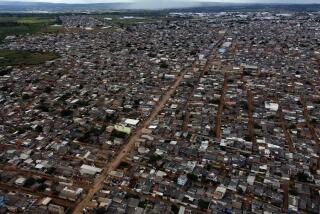Brazil’s Outlook Brightens Even With Latest Jump in Inflation
- Share via
RIO DE JANEIRO — Despite a resurgence of inflation in October, Brazil is suddenly looking healthier. By implication, so are the neighbors and trading partners of South America’s largest economy.
Soaring stock prices, an improved credit rating and declining interest rates suggest that Brazil is slowly getting a grip on itself after being forced to devalue its currency in January. The country recently posted its first back-to-back monthly gains in industrial output since early 1998.
Thursday’s report on inflation showed the highest monthly jump in more than three years--to an annualized rate of 13%--sounding a cautionary note for a nation still buffeted by political uncertainty and other crosscurrents.
But it didn’t bother investors. Brazil’s biggest stock market continued an upward march, closing at its highest since July 1997, the start of the Asian economic crisis.
Markets were buoyed by Standard & Poor’s revising its outlook on Brazil’s foreign and domestic currency debt to stable from negative Wednesday, in recognition that Brazil’s government is undertaking “fiscal austerity and monetary discipline,” S&P;’s lead Latin America debt analyst Lacey Gallagher said.
Meanwhile, the benchmark overnight interest rate stands at 19% compared with 45% in March, when Arminio Fraga, a former associate of investor George Soros, took over as head of the central bank. His appointment is widely perceived as a turning point in Brazil’s rehabilitation.
S&P;’s Gallagher said new taxes and spending cuts will help Brazil cut its government deficit in half next year, to 5% of economic output, explaining the improved credit rating. Brazil’s fiscal red ink was a principal factor in the loss of investor confidence earlier this year.
Other positive signs for Brazil are a shrinking trade deficit and relatively tame inflation that, despite the unexpectedly high figures released Thursday, has defied the naysayers by staying in single digits. Even with the 1.19% rise in the October consumer price index, inflation for the full year is expected to be between 8% and 9%.
That’s higher than hoped for, but half the rate that many economists were dolefully predicting after the devaluation raised fears of a new round of hyper-inflation, Brazil’s long-standing nemesis.
While not dismissing the inflation threat, the rise in October prices “qualifies as a short-term blip on the screen” attributable to seasonable pressures and lingering effects of the devaluation, said Francis Freisinger, Latin America economist at Merrill Lynch in New York.
In agreement was Rubens Sardenberg, chief economist for ABN AMRO Bank in Sao Paulo, who minimized the threat of a new inflationary cycle and noted that much of the October price pressure came from one-time auto price hikes. Wages, health and household costs were relatively stable, he said, adding that he expects inflation to “reverse itself” by December or January.
Also positive for Brazil is a developing political consensus at both the state and federal levels that waste in Brazil’s pension system and civil service must be cut, said Edmar Bacha of BBA-Creditanstalt of New York.
Twenty-three of the nation’s 27 governors support two constitutional amendments proposed by President Fernando Henrique Cardoso to trim the social security system and bloated state salaries.
The stock market is being driven up largely by foreign dollars attracted anew by projections that Brazil’s economy will grow 3% to 4% next year, after zero growth in 1999. Some economists feared that Brazil’s economy would shrink by 5% this year.
“Typically after a devaluation like we witnessed in Brazil there is a much greater contraction because it puts imported goods out of consumers’ reach. Brazil . . . was less dependent on imports than thought,” said Larry Goodman, managing director of Globalecon consultants in New York.
Brazilian economic expansion would be good news for surrounding countries, especially Argentina, which depends on the Brazilian market for 30% of its exports.
“The faster Brazil grows, the better for Argentina, because its exports will be supported by a Brazilian recovery,” said Freisinger, who sees a 2.5% expansion in store for Argentina’s economy next year.
Brazil has a long way to go: Many of the austerity measures are short-term and must be replaced next year by permanent laws, Gallagher said. Moreover, Brazil’s horrific budget deficit leaves the country little breathing space should international confidence be rocked again by some unforeseen trauma.
The weak exchange rate for Brazil’s real remains a source of worry as Brazil struggles to pay its mountain of dollar-denominated debt, which adds up to about one quarter of the country’s economic output. Too much of Brazil’s resources are going to pay debt instead of to its human resources, said Globalecon’s Goodman.
A further weakening of the real would make it harder for the government to jawbone labor unions to hold the line on wages and keep inflation down, said ING Barings economist Mauro Schneider. He added that Brazil and other emerging markets remain susceptible to an economic downturn in the United States.
Political support for austerity measures is always tenuous at best, as illustrated by Wednesday’s demonstration by hundreds of thousands of Brazilians who struck in protest against the unemployment and recession they said were caused by the government’s economic policies.
And while Brazil’s trade deficit in 1999 will drop to about $1 billion, that is far short of the $10-billion trade surplus that some in the government had hoped would result from the devaluation, said Paulo Levy of the Rio-based IPEA think tank.
(BEGIN TEXT OF INFOBOX / INFOGRAPHIC)
Brazil Bounces Back Brazil’s key short-term interest rate has fallen this year ...Thursday: 19%
... the country’s Bovespa stock index has soared.Thursday: 13,189.3
Sources: Bloomberg News, ABN Amro Bank
More to Read
Sign up for Essential California
The most important California stories and recommendations in your inbox every morning.
You may occasionally receive promotional content from the Los Angeles Times.













